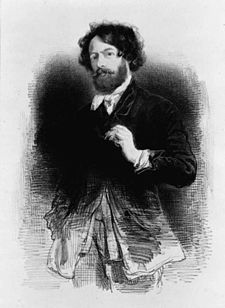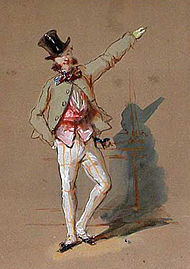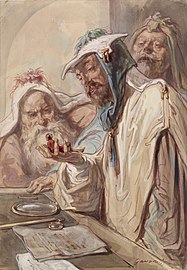Paul Gavarni
| Paul Gavarni | |
|---|---|
 autoportrét, litografie (1842) | |
| Rodné jméno | Sulpice-Guillaume Chevallier |
| Narození | 13. ledna 1804 Paříž |
| Úmrtí | 23. listopadu 1866 (ve věku 62 let) Auteuil |
| Místo pohřbení | Hřbitov Auteuil |
| Povolání | karikaturista, malíř, ilustrátor, kreslíř a grafik |
| Děti | Pierre Gavarni |
| Hnutí | romantismus, kritický realismus |
| Ocenění | rytíř Řádu čestné legie |
| Některá data mohou pocházet z datové položky. | |
Paul Gavarni, vlastním jménem Sulpice Guillaume Chevalier, také Hippolyte-Guillaume Sulpice Chevalier, (13. ledna 1804 Paříž – 23. listopadu 1866 Auteuil) byl francouzský malíř, grafik, ilustrátor a karikaturista.
Život
Začínal jako dělník – mechanik ve strojírenské továrně, ale byl nešikovný. Dal se zapsat do kursů kreslení a v tom dělal rychlé pokroky. V počátcích kreslířské kariéry si zvolil pseudonym podle obce Gavarnie v Pyrenejích, kam jednou cestoval. Začínal jako ilustrátor módního časopisu Journal des modes, kresby prováděl technikou litografie, zprvu ručně kolorované, později tištěné barevně. Od roku 1828 se jeho ilustrace stále více stávaly karikaturami. V letech 1837 až 1848 byl karikaturistou a ilustrátorem satirického časopisu Le Charivari. Při pobytu v Londýně v letech 1848 až 1851 zaměřil svou kritickou pozornost na obyvatele chudých čtvrtí, vytvořil celé album, které pod názvem Londýn a Angličané vydal se svými texty Émile de la Bédollière roku 1862. V kresbách moralit pokračoval i po návratu do Paříže, stovkami karikatur mapoval společenský a kulturní život Pařížanů. Jeho kreslené vtipy s krátkým textem byly tak populární, že se každý tiskl na celou stranu. Oproti svému vrstevníkovi Honoré Daumierovi se nezabýval portréty politiků, karikaturami konkrétních osob a grimasami jejich tváří, ale na situace a slovní doprovod.[1] Byl mistrem litografie, což vyhovovalo vydavatelům tehdejších časopisů i knih. Významné práce vytvořil také akvarelem. Byl střídavě úspěšný a neúspěšný, také jako redaktor a vydavatel. Dostal se krátce do pařížského vězení pro dlužníky a z pobytu vytěžil soubor karikatur. Obdivoval vědeckotechnické vynálezy, pokoušel se létat v balóně, na rozdíl od svého přítele, fotografa Nadara neúspěšně.
Jeho syn Pierre také kreslil, ale nedosáhl úspěchů.
Dílo
- Les Oeuvres nouvelles. Les Partagueses. 1., díl, Paříž 1855; Album vybraných karikatur, litografie, (dostupné online:[1])
- Ilustrace románů Honoré de Balzaca, Eugene Sue: Věčný Žid, Jonathan Swift: Gulliverovy cesty, Hoffmannovy povídky, a další.
Galerie
- Výběr z díla
Pařížský dandy, kresba
Ilustrace módního časopisu, litografie (1835)
Pařížský karneval (1841)
Prodavač čokolády (1855–1856)
Gulliver a tři filozofové (asi 1862)
Okouzlena hudbou (1839)
Odkazy
Reference
- ↑ Henri Frantz and Octave Uzanne:Daumier and Gavarni; London: Offices of "The Studio" 1904
Související články
Externí odkazy
 Obrázky, zvuky či videa k tématu Paul Gavarni na Wikimedia Commons
Obrázky, zvuky či videa k tématu Paul Gavarni na Wikimedia Commons
Média použitá na této stránce
Les Muses, La Musique, de Paul Gavarni, Paris, 1839, Armelhault & Bocher, no. 290
Autor: Rijksmuseum, Licence: CC0
Identificatie
Titel(s): La Mode, ca. 1835
Objecttype: modeprent
Objectnummer: RP-P-2009-3067
Omschrijving: Twee vrouwen en een man bij een openhaard. Japon, versierd met gestreept lint en bloemen. Sjaal. platte schoenen met vierkante neuzen. Man in lange jas, vest en lange broek. Geknoopte halsdoek. Gestreepte kousen. Lage schoenen met vierkante neuzen. Prent waarschijnlijk uit het modetijdschrift La Mode (1829-1855).
Vervaardiging
Vervaardiger: prentmaker: Paul Gavarni (vermeld op object)
Plaats vervaardiging: Parijs
Datering: ca. 1835
Fysieke kenmerken: lithografie, met de hand gekleurd
Materiaal: papier
Techniek: lithografie (techniek) / met de hand kleuren
Afmetingen: blad: h 174 mm × b 139 mm
Onderwerp
Wat: fashion platesdress, gown (+ women's clothes), clothing for the upper part of the body (SHAWL) (+ women's clothes), trousers, breeches, etc. (PANTALON) (+ men's clothes), clothing for the upper part of the body (VEST) (+ men's clothes), shoes, sandals (+ women's clothes), neck-gear ~ clothing (+ men's clothes), shoes, sandals (+ men's clothes), coat (+ men's clothes), open hearth, fire-placenecklace (+ women's clothes)
Wanneer: 1835 - 1835
Verwerving en rechten
Credit line: Aankoop uit het F.G. Waller-Fonds
Verwerving: aankoop 2009
Copyright: Publiek domein
The best-known episode from Swift's "Gulliver's Travels" involves a sojourn amongst the tiny Lilliputians. Subsequently, the hapless Gulliver sails to the island of Brobdingnag, whose inhabitants are as giant as the Lilliputians were tiny. This drawing depicts an episode that Swift uses to satirize the learned conventions of his day. Gavarni accordingly clothes the scholars of the Brobdingnagian court in a parody of the academic robes of his own era. "His Majesty sent for three great scholars. . . . These gentlemen, after they had a while examined my shape with much nicety, were of different opinions concerning me. They all agreed that I could not be produced according to the regular laws of nature, because I was not framed with a capacity of preserving my life, either by swiftness, or climbing of trees, or digging holes in the earth. They observed by my teeth, which they viewed with great exactness, that I was a carnivorous animal; yet most quadrupeds being an overmatch for me, and field mice, with some others, too nimble, they could not imagine how I should be able to support myself, unless I fed upon snails and other insects, which they offered, by many learned arguments, to evince that I could not possibly do. One of these virtuosi seemed to think that I might be an embryo. . . . But this opinion was rejected by the other two, who observed my limbs to be perfect and finished, and that I had lived several years, as it was manifested from my beard, the stumps whereof they plainly discovered through a magnifying-glass. . . ."













